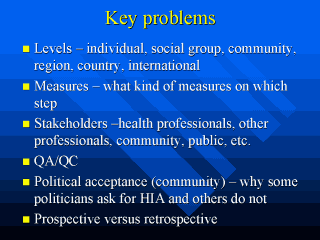 |
As each newly
developing methodology HIA also has his pitfall points or points which deserve more
importance regarding future development and better public acceptance. Those listed on this
slide definitely belong among them. Levels of HIA are frequently points of discussion.
What is an appropriate level of society where HIA methodology is worhtwhile to apply. The
range is from indiviuals to international level and it is practically impossible to give
answer. But, when doing screening this point must be taken in account. An important
question is the question of measures used for assessment. Health professionals are
frequently used to use mortality based measures in epidemiology. One point is if these
measures are really the best for presenting impacts of policies, projects, investments, or
should we rather look for other measures? It is also important to mention that they might
be differences between measures used in different steps of HIA procedure. One can use
different measures in screening and different in implementationa dn monitoring phase.
Another scale is the level scale; different measures are definitely needed for different
level for which HIA is conducted. I such a broad procedures as impac assessments are
inspite of their focus, the question of staholders is always crucial. In case of health
even more, due to frequetnly existing way of thinking that non-health professional should
contribute to health related issues (I am sure, this opinion is still widely present in
several countries). Quality assurance and quality control is an un-opened, but for future
necessary field of health impact assessment. How can one know who is doing a good job and
who a bad one? Clear QAQC rules, similar to those established for example for laboratory
practise, or even in epiediomology are expected to develop in close future. Of course from
point of view of objective of HIA public and political acceptance is the most important.
How can we achieve wide acceptance and use of HIA as it is intended to be used? The case
of British Columbia in Canada described by Banken (23) is a good example, which shows that
it is necessary to deal with this topic. Another question si at what extent are the
results and experience from retrospective and prostective HIA same? Can we compare them,
is their scinetific and public policy value the same, or is there some difference? How
much can we learn from retrospective HIA’s, what is the role of different latency
periods introduced by measures used on the results? All these questions opens field for
new research. |
